Is It True Taht an Animal Caught in a Live Trap Will Not Enter One Again
Module 8 Trapping
Trapping involves the use of mechanical devices that capture animals without the trapper being present. Trapping is ane of the most common and effective methods that landowners use for managing wildlife harm because traps are fourth dimension savers. Traps work fifty-fifty when you lot are not present.
Objectives
- List the different types of cage and box traps.
- Place the parts of a cage and box trap.
- Depict different sets used to capture animals.
- Explain principles and techniques used to reduce capture of non-target animals.
Definitions
In Module 5, Wildlife Control Methods, nosotros reviewed the methods available to command wildlife. In this module, we will focus on the utilise of cage and box traps to manage wildlife that cause conflicts. Many people apply the term "live trap" to identify traps that capture animals by imprisonment in a box. We find the term "live trap" to be misleading, as well as inaccurate, considering some traps that grasp parts of the animal's body (east.g., footholds or cable-restraints), also capture animals alive. Instead, nosotros prefer to apply the terms cage traps and box traps to identify devices that capture animals past imprisoning them. Muzzle traps have walls fabricated of wire mesh. Box traps have solid walls usually made of forest, plastic, or sheet metal (Figure 1).
Types of Cage & Box Traps
Manufacturers produce muzzle traps (Figure 2) and box traps with unlike features. This section will discuss a few of the more important ones.
- Gravity vs. bound-loaded doors. Gravity doors, as the name suggests, ways that when the trap is sprung, the door falls due to gravitational force. Spring-loaded doors close with the aid of a bound. Spring-loaded doors require the trapper to manually depress the spring to open the door.
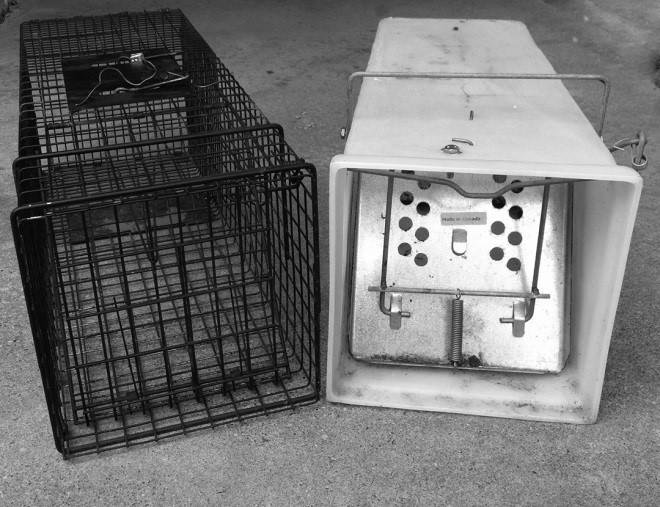
Each type of door has advantages and disadvantages. Gravity-door traps tend to exist less expensive and don't have springs that can wear out. Non-target animals tin be released easily by gently rolling the trap over on its top. The disadvantage is that animals sometimes roll the trap over and escape when the door opens. Jump-loaded doors allow fewer escapes because the door tin can't open up if the trap is rolled over, and the door will close even when the trap is not on level basis.
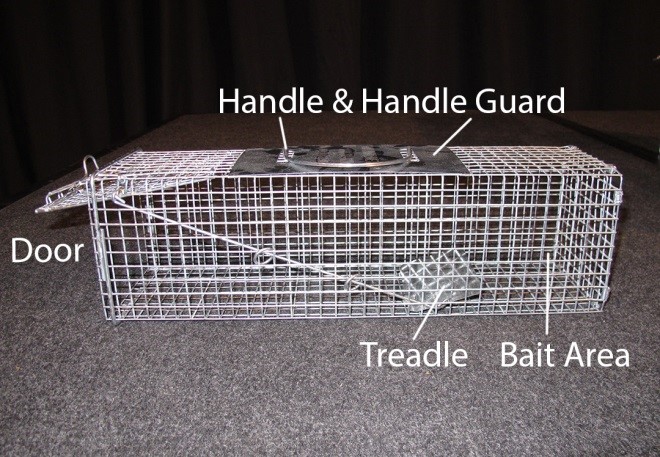
- Single-door or ii-door traps. Single-door traps are the most mutual blazon of cage and box trap. Allurement is placed on 1 finish and the creature must enter the other terminate to attain the bait. A ii-door trap has an opening on both ends, giving the appearance of a tunnel to an fauna.
Traps for Homeowners vs. Professionals
Manufacturers produce cage traps for homeowners (retail-grade) as well as professionals, such equally wild animals control operators (WCOs). Although the traps may appear the same, closer inspection reveals they can be quite different. In general, retail-grade traps have thinner-gauge metal and wider mesh (i.e., one- x 1- inch; Figure 3a). They may not have handle guards. Professional traps typically are made with one- 10 ½-inch mesh for much of the cage (Effigy 3b). The benefit of using traps with narrower mesh is that captured animals are less probable to tear up turf or damage items nearby. In addition, it is harder for them to scratch yous equally yous carry the cage. Handles are positioned to keep the cage in balance, and the guards are big plenty to protect your hands. Both versions are effective in capturing animals.
Effective Use of Traps
The apparent simplicity of muzzle and box trapping is deceiving. While setting muzzle or box traps does non require a college caste, effective trapping involves attention to details for improving capture success.
Step 1. Safety starting time
Always wear protective work gloves when handling traps. Gloves help protect you from cuts from sharp edges on the metal, too as any contaminated material that may exist adhering to the trap.
Step 2. Know how to handle a trapped animal Earlier you set up a trap
People oft capture animals without a plan for handling them. This is specially truthful for people who accidentally capture a skunk.
Pace three. Know the target animal
The target species determines the size and type of trap needed. Every bit a full general dominion, use the smallest trap necessary to capture the target creature. Smaller traps help you avert captures of non-targets because smaller sizes make information technology difficult for larger animals to enter.
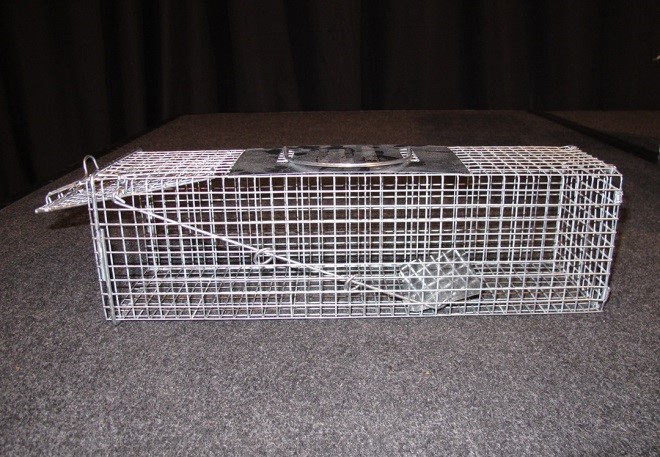
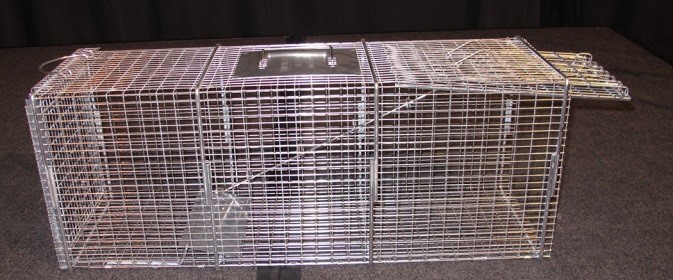
Step iv. Choose a good location
Place the trap so that the target animal can accomplish information technology easily. Place traps at to the lowest degree 12 inches away from sensitive items to prevent trapped animals from damaging personal property (Figure 4).
Pace 5. Prepare the trap so it does not wobble
Fifty-fifty though the footing may wait level, it often has bumps and depressions that tin cause a trap to wobble every bit the animal steps on the trap floor. Wobbly traps are empty traps. To ensure the trap is stabilized properly, scrape the soil to level it. Press down on various areas of the trap to see if information technology will tip.
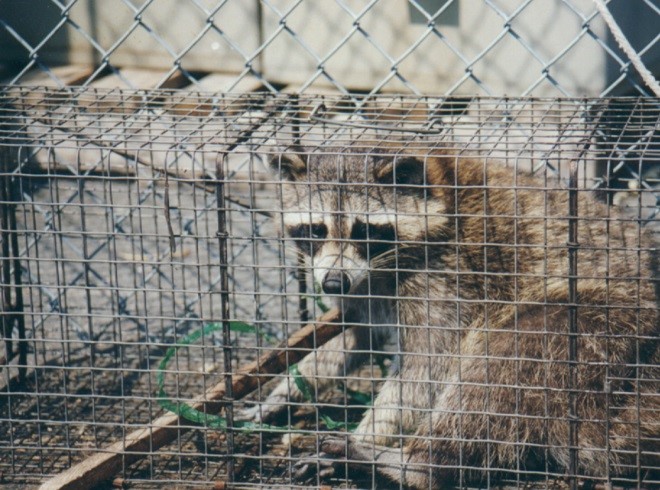
Step half dozen. Select the right set, and monitor traps on a daily basis
Sets are discussed later in this module. Traps must be checked every day regardless of weather or holiday status. If you can't check the traps daily, either close the traps, or secure the doors so that they cannot shut. If practical, check traps in the morning and evening so that animals volition be in the trap for less fourth dimension.
Step 7. Use enough of traps
Setting ane trap can be effective; however, this is like hunting with i bullet. Nosotros recommend setting three traps when trying to capture animals squirrel-sized and larger. Use more when trying to capture smaller animals.
Trapping Sets
A set encompasses the employ of the trap and its unabridged placement. Sets are categorized as baited, blind, and positive.
Baited sets are the most common, and they rely on a lure or allurement to attract an animate being into the trap. Use bait that selectively attracts the target species.
Trappers commonly exploit an animal's sense of smell. Bait a trap so that the odors of the food or lure have an opportunity to disperse into the air. One method uses a forked stick. Scoop out some of the bait from its container with the stem of the stick. Insert the stem towards the back half of the bait area of the cage trap, then that the forks grab onto the trap mesh, and let the stem to dangle. Make sure that the stick volition not move much in the current of air. Failure to consider this may let the animal to catch the allurement without getting close enough to depress the treadle. With this method, the bait has very loftier exposure to air, while keeping bait off the basis and away from ants.
An alternative bait stick consists of a T-shaped plastic (PVC) pipe with holes in it (Figure 5). The PVC pipage is long-lasting and volition non be thrown off heart when yous cover the cage with a material. To use the PVC allurement stick with liquid bait, attach a cap to the end of the PVC pipe. The location of the get-go drilled hole will determine the corporeality of liquid bait held. Push the end-cap on without using glue to allow the liquid bait to seep out slowly, permeating the area with attractant.
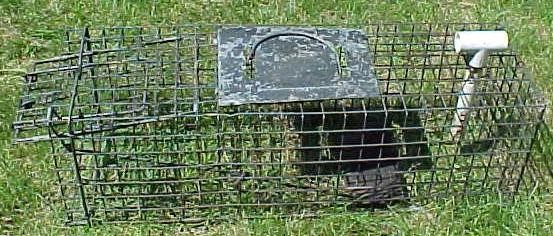
Liquid bait can also be held in a 2-inch PVC pipe (Effigy six.) Seal the bottom opening with an stop cap and use a spiral cap for the tiptop. Drill holes in the upper portion and then that odors can escape.
Some other way to bait a cage trap is by using trapper's wire and cotton assurance. This technique is useful for liquid-based baits and lures because cotton absorbs the liquid. Skewer six cotton wool balls with wire and curve the wire so they volition not slide off. Brand a loop in the other cease to hang the wire from the cage. Hang the bait wire toward the back half of the bait area. As with whatever hanging method, brand sure that the wire will not movement much in the wind. Otherwise an animal may grab the bait without getting close enough to depress the treadle.
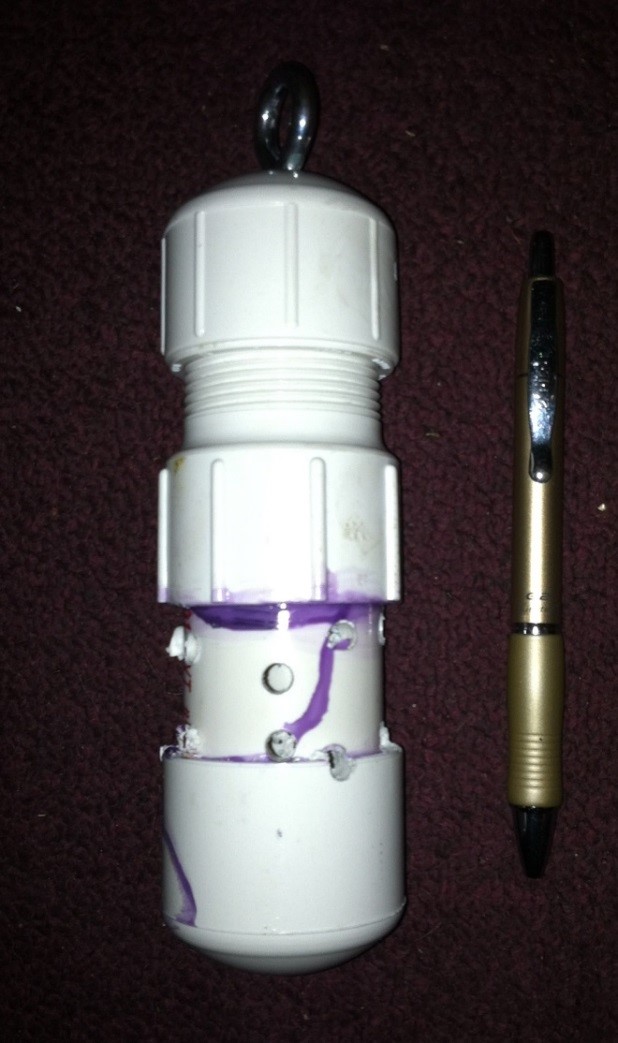
In situations where hanging allurement is not possible or practical, use eye appeal. One WCO uses Chef Boyardee® microwave dejeuner buckets to trap raccoons. The small-scale white plastic bowls have lids with holes. Allurement is placed in the basin and covered with the hat. The white bowl attracts the raccoon, the holes let the odor to disperse through the air, and the chapeau helps protect the bait from getting washed out by pelting. Yogurt containers with holes cut in the lids likewise piece of work. Ensure that baited containers weigh enough to forestall them from being blown over by the wind. Add minor rocks to a container to keep information technology in place. Sight attractants are specially of import for skunks or raccoons. Place marshmallows in the back of a trap to attract them in the dark.
Blind sets rely on the movement of the animal to trigger the trap, and no bait is used. A 2-door trap set in an beast's trail is a classic example of a bullheaded fix (Figure 7).
Advantages of this type of gear up include no bait to maintain or that might be refused by the animate being, and the set only captures animals using the trail or path. The disadvantage is that these traps are larger and tend to be more expensive than single-door traps.
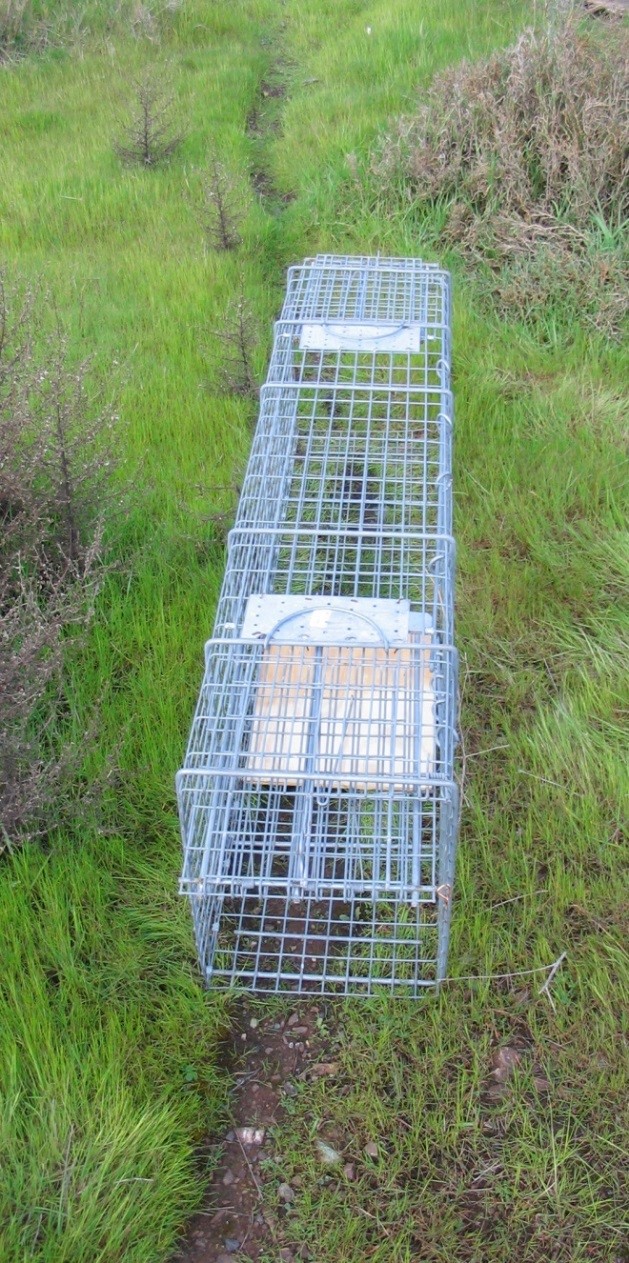
Positive sets refer to traps placed over or in front of an entrance pigsty, and barricaded to funnel the animals(s) into the trap (Figure 8). Positive sets catch but problem animals equally only animals exiting the hole can be captured. Positive sets are used to remove animals from nether sheds, decks, or in den holes.
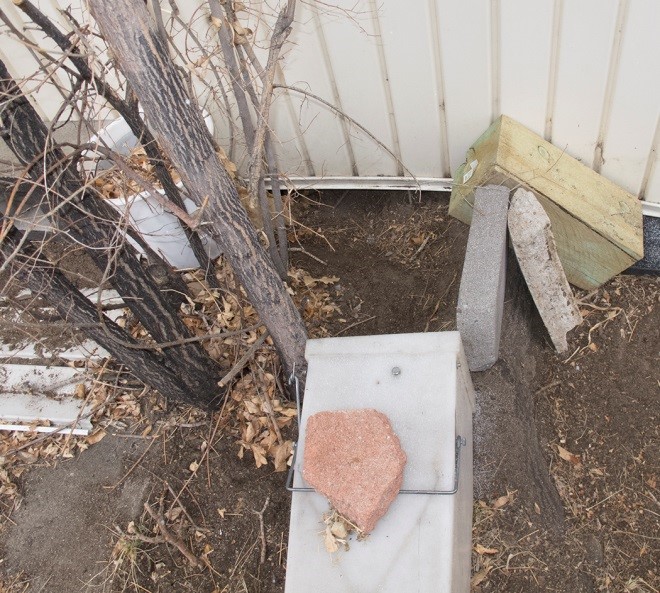
Humane Trapping
Many people mistakenly recall that cage and box traps automatically are humane. The fact is that humane trapping involves not merely the device, but too the skill of the trapper. Foothold traps used by an experienced trapper tin can be more humane than a cage trap used by an inexperienced landowner.
A few simple steps tin significantly meliorate the welfare of animals in cage and box traps. First, consider weather conditions and reduce the beast's exposure to temperature and weather extremes. For example, embrace one-half the length of a cage trap to provide an area where a caged animal can obtain shelter from wind, rain, lord's day, and prying eyes (Figure nine).
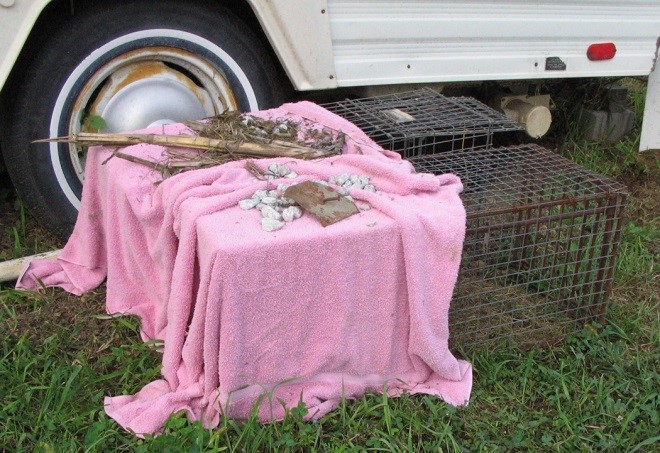
Plastic box traps keep animals up to 12°F warmer than comparable muzzle traps. While plastic traps provide greater warmth for animals in the winter, they may get likewise hot for animals in the summer. Likewise, muzzle traps may be as well cold in the winter, but may be a better choice in the warmer months. Consider how air current, snow, rain, and sun will touch on the trapped animal and try to minimize those impacts.
Second, check traps often. As stated earlier, traps must exist checked daily. If possible, bank check traps twice a solar day (morning and evening) to reduce the length of time an animal is in the trap.
Third, apply selective trapping techniques to reduce the likelihood of capturing non-target animals. Use as many of the approaches listed beneath equally are practical.
- Use the smallest trap possible to catch the target animal.
- Locate traps where target animals are traveling.
- Utilize baits and lures that are less attractive to non-targets. For example, sweet baits such as molasses and sugar wafers are less attractive to house cats, just are desirable to raccoons.
- Close traps during the day when trapping nocturnal animals, and at sunset when trapping diurnal animals.
Trapping has an important place when using IPM in wildlife damage management. Diligence in selecting a location, setting, and monitoring traps will ensure not only success but also the humane treatment of captured animals.
Module nine addresses what to do with animals that have been trapped. Some states (e.grand., New York), do not allow landowners to move trouble wildlife from their property. A WCO license or state allow may be required for live transport of wildlife.
Questions for Reflection
- Why is information technology important to understand the different types of cage and box traps?
- Why is it inaccurate to utilize the term live trap to refer but to cage and box traps?
- What does it mean to trap humanely?
- Why is proper baiting technique important when using cage and box traps?
- List a few aspects involved in setting cage and box traps properly.
Source: https://wildlifecontroltraining.com/training/trapping/
0 Response to "Is It True Taht an Animal Caught in a Live Trap Will Not Enter One Again"
Postar um comentário